Kristina Dolgilevica took a second trip to Korea to learn traditional archery, and gave us a taste.
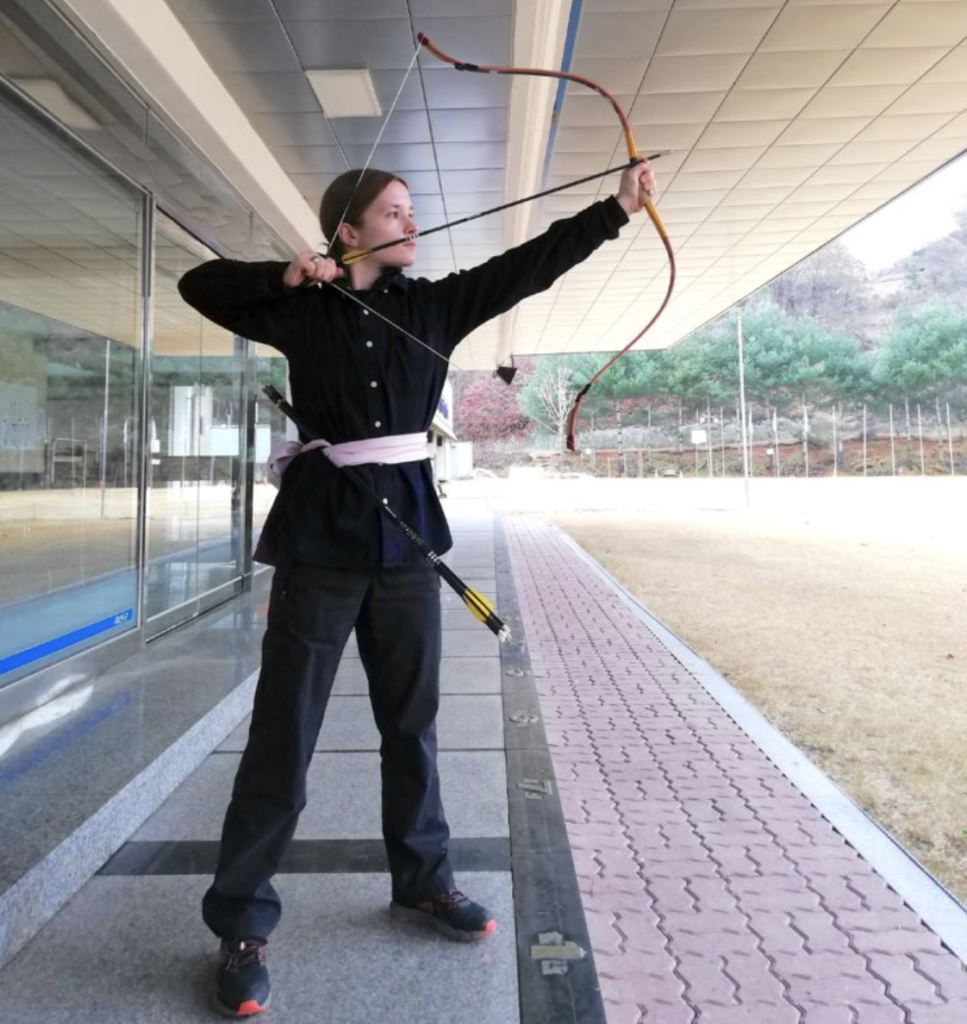
Korean traditional archery (KTA), much like Japanese kyudo, descends from both martial and ceremonial practices. Thanks to various Imperial campaigns to preserve archery culture, both disciplines were subject to many revivals from the 16th century onwards, an era when mechanical weapons took over as the principal instrument of warfare.
Today, much like Kyudo, KTA is practiced as a form for teaching self- discipline, etiquette and as physical exercise. But while kyudojos can be found outside of Japan, (especially in USA, Europe, UK), you never see a KTA clubhouse outside Korea.
Why is it that you can easily purchase a Korean practice bow anywhere in the world, but you can never practice it in its true form? Part of the answer lies in that the only KTA discipline practiced in Korea today is shot at 145m distance.
There were once at least five other to test a military man’s wide skillset. One type was similar to clout shooting, another shot on horseback and so on. Another reason is that, unlike at least a handful of kyudo masters, KTA masters do not travel outside Korea, and that there aren’t many committed Western students in KTA Association, as one master put it: “There are only a couple of retired Western gentlemen who took it up as their leisure”.
As a traditional archer myself, out of all the disciplines I found the Korean horsebow most enjoyable and challenging, and set out on a second trip to South Korea to take a closer look and experience the bow in its authentic form.
Equipment
There are two types of Korean bow in use today: synthetic and traditional. The first has some natural materials, the latter is all natural. The principal difference between those two types is what makes the limbs flex: the mixture of layered wood and fiberglass in a synthetic bow, and for traditional, thinly sliced buffalo horn layered with sinew and natural fish glue.
Similarly with arrows: there are carbon shafts with plastic nocks and bamboo shafts with quail feathers. A traditional bow can easily cost you over a thousand dollars.
The particular Korean clubhouse will dictate which equipment they want their students to use, but most commonly, an archer will get a ‘proper’ traditional bow once he/she receives a Master dan rating 5 (out of 9), which can often take ten years.
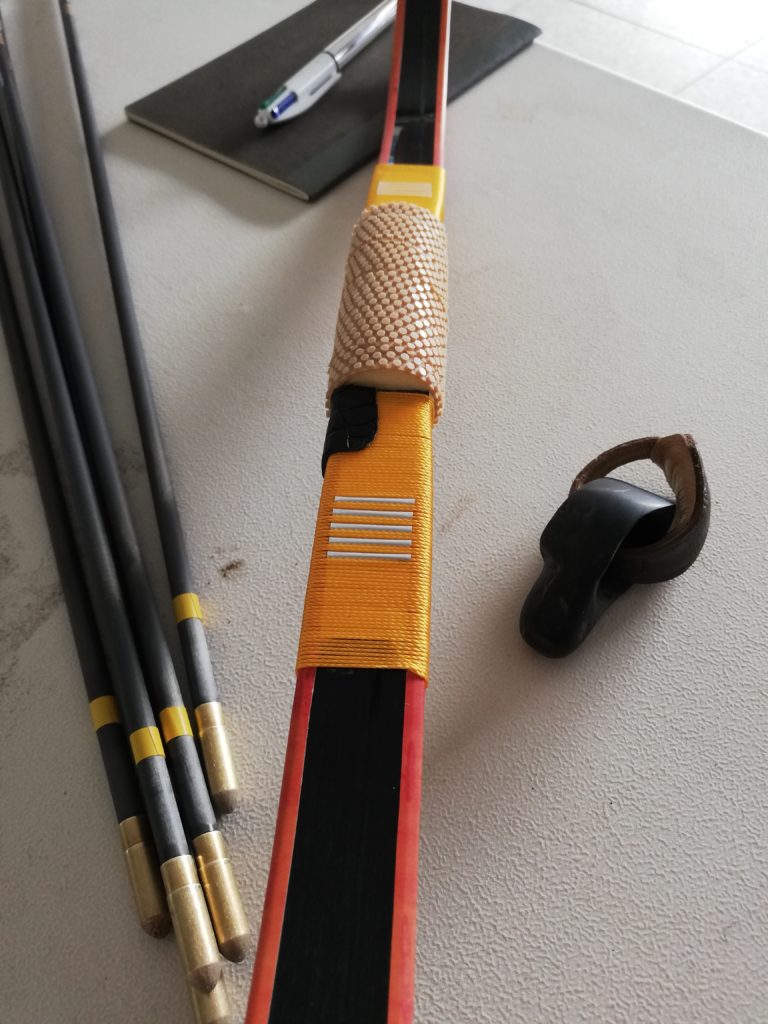
There are further unique features that distinguish KTA from other traditional disciplines: notably, the arrow, the ring, and the target. The arrow tip is blunt and is designed to bounce off the target: the arrow lasts longer and it makes it impossible for a ‘robin hood’ to happen.
Easton now makes a special KTA carbon shaft, with a plastic nock imitating the bamboo cut groove. A little hole is made inside of the nock to better distribute the pressure and minimise the damage to the shaft upon impact.
KTA is shot with thumb rings. The ring made of water buffalo horn (gakji) is used only in Korea and is different to other thumb rings; it has a ledge, and the thumb is not bent at a 90 degree angle to form a lock.
It is instead kept straight with the string placed behind the ledge and lightly covered with the index finger to lock the arrow in place. This type is also known as the ‘male’ ring. The ‘female’ version has no ledge and is very similar to a Mongolian or a Turkish style ring, where the thumb will be bent to lock.
Targets and grading
The target is set at 145 metres and stands 2.66m tall and 2m wide. Typically three or four numbered targets are set in line, in a natural setting (e.g. a mountainous terrain, by the shore etc).
Rather like a permanent field archery installation, each range will present the archer with a unique challenge, unique light, wind conditions and so on. The targets are always surrounded by a sand pool to further minimise any damage to the arrow and slow it down, much like the safety curtain would in the indoor setting.
Today, the colours on the target do not indicate numbers. A hit anywhere gives one point, all other arrows are a miss and carry no points. Modern target boards are fitted with sensors, when the arrow hits, the light behind the target will blink, and the sound will be transmitted to the clubhouse.
On the shooting line, under the canopy, there will be seven numbered spaces assigned to each target. Those senior, or higher in rank will assume first positions and will be followed by those less experienced.
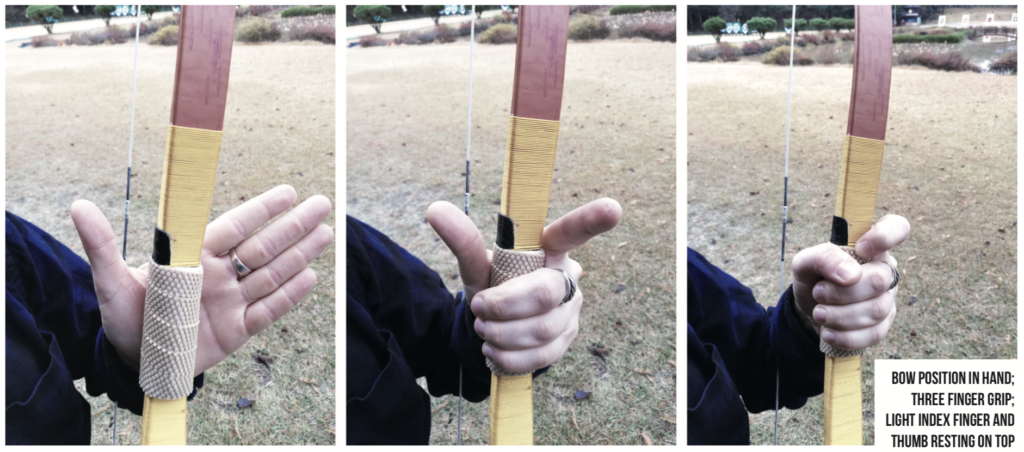
KTA uses a martial-arts style dan grading system and awards belts for increasing rank. Dan grading is counted from 45 arrows shot at competitions.
Each end comprises of five arrows, so the archer gets grading from nine ends. The first grading starts at 25 hits out of 45. A 2nd dan needs 28 hits, 3rd 29, 4th 30, 5th 31 for a Master belt, and so on until the ninth dan which needs 39 hits. It gets a little easier to progress after the first dan, however it does take a lot of practice time to get there.
With every new dan, an archer gets a new belt, but unlike in other martial arts, the colour of an archers belt does not reflect their rank. Most students first get a blank cotton belt which acts as a quiver when shooting.
It is tied in a certain way, so that the pocket end will carry the archers name, club or district information, and rank – which takes form of an embroidered Rose of Sharon, Korea’s national flower.
These belts are made of silk. Recently, belts given out to archers have been dark blue or orange, but again there is no significance and some archers can even choose the colour.
Moreover, once the archer achieves a certain rank, he or she is not obliged to wear that belt and can use any one in their possession. Once you achieve a certain rank, it’s yours for life.
Technique and form
There are a few interesting features in archers form. The archer’s stance is opened to the target, and their position will change depending on which target they are shooting at.
The basic rule (for right handers) is that the toes of the bow foot must face the left side of the target, the other foot opens at around a 90 degree angle while the body centre remains fixed, like with other bowstyles.
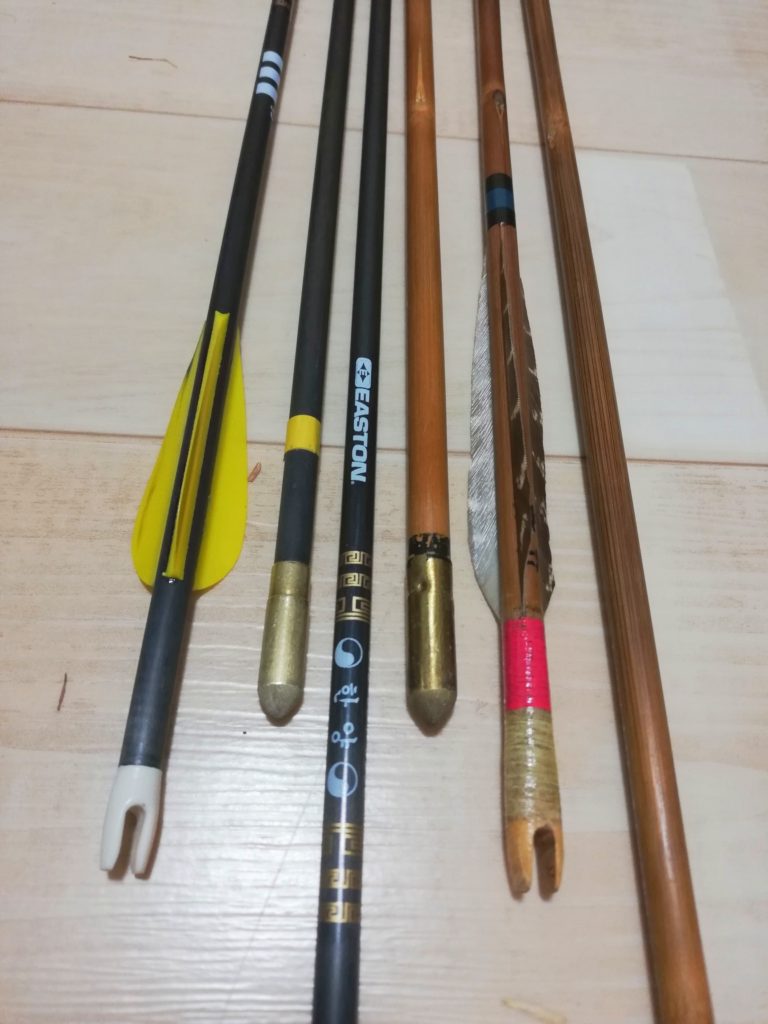
At the set up position, both arms are raised and bent at the elbows, with the bow slightly tilted. Because we use the gakji thumb ring, we overdraw past the face.
The overdraw gives you extra draw length, and as a result, extra poundage. Typical KTA anchors are drawing past the eyebrow to the ear, with the arrowshaft placed over, to or under the jaw bone- it depends on the draw length and bow poundage.
Historically, most traditional anchors were at ‘arrow to the mouth’ height. The lightest bow poundage an archer can use to hit the target at 145m is 35lbs.
The archer holds the bow with three fingers, with the thumb and index fingers relaxed. The thumb knuckle acts as an arrow rest. From the set up position, the bow hand is in a continuous twist. The sensation is as if your thumb is pushing itself out and the rest of the fingers are constantly clutching and turning the bow to the left.
This twist is maintained at the set up, during drawing and after the release, which gives the arrow its straight trajectory. At the finishing position the bow wrist ends up in a twist, so that your bow is physically twisting to the left from the wrist only (it is very easy to move the whole arm into the direction of the twist, but it should not be done).
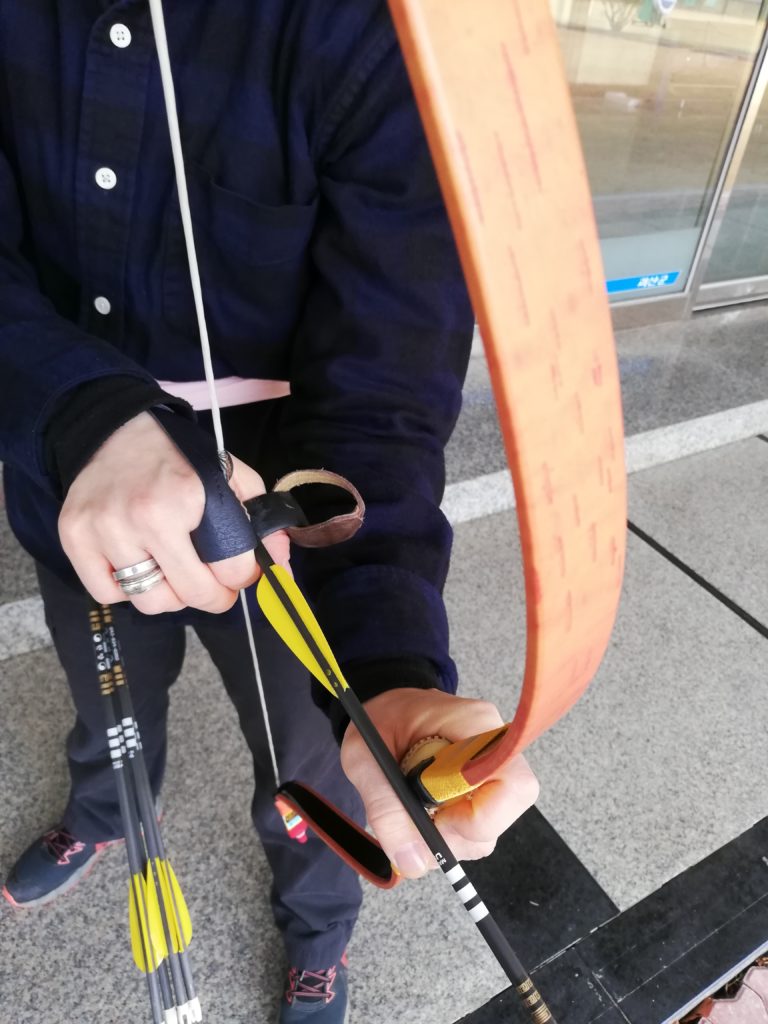
If the archer relaxes or does not do the bow twist, the arrow flies off-centre and sometimes the string will slap the archer’s face. This twist can be better observed in kyudo, where the bow almost springs 360 degrees in the archer’s palm. The motion and direction is the same for KTA, but the physical movement of the bow is much smaller.
At full draw, an average archer will typically hold for 3-5 seconds, and because of the nature of the overdraw, the archer’s chest will slightly expand, which would be an unacceptable thing to do when shooting with an anchor fixed on or to the face.
Practice – and etiquette
Most serious archers will shoot every day, regardless of the weather conditions, but they will not usually keep an arrow count. Some will pop in to their club during lunch break at work, some will shoot in the morning before work and some after.
Most clubhouses will allow for shooting after dark, because they are equipped with additional lighting, and for some practitioners shooting in the dark with a projector light is the ultimate way to perfect their skill, because a little less of the senses are activated and an archer can focus on the feeling of the bow. It can be likened to shooting blindfolded.
Upon entering the clubhouse, every archer must bow before the sign with the Chinese inscription ‘Jung Gahn’, paying homage and respect to the gallery of the masters whose portraits hang in the adjacent room in the very centre of the clubhouse.
The use of the Chinese language is in keeping with Confucian values which predate Hangul, the Korean alphabet, and once again point at the long-standing traditions of Korean traditional archery.
The clubhouse will display a table of rules of conduct and the meaning of practice. There are nine traditional precepts, most commonly applied both in Korea and China, those will have a couple of practical points added to the list, in keeping with the modern day running of the club, but the core precepts remain the same as they were centuries ago.
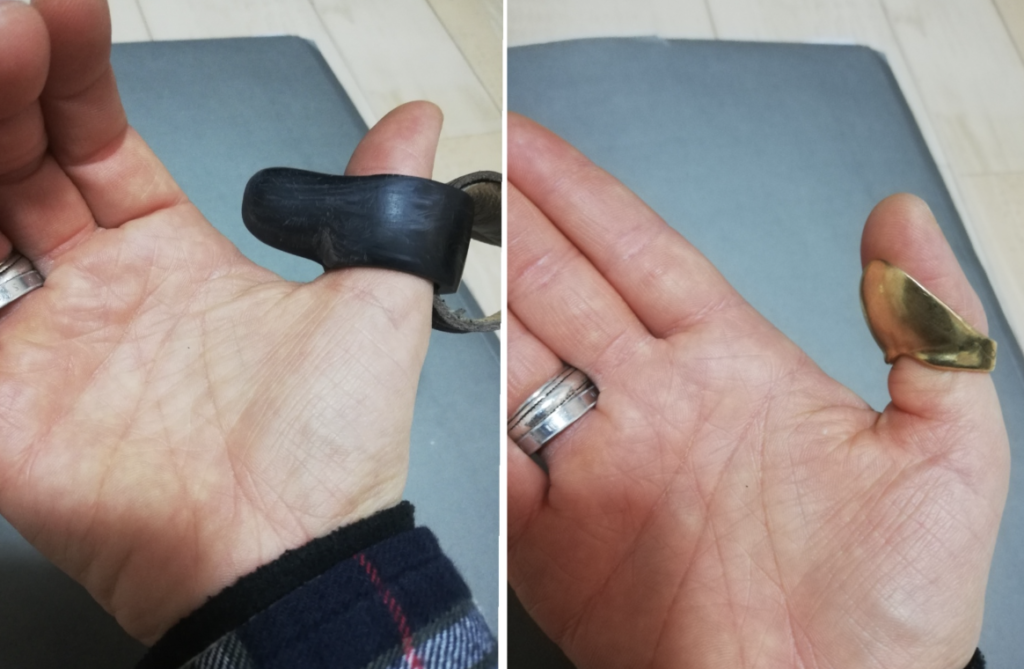
Core principles talk about exhibiting respect to one another regardless of rank and experience. They talk about respecting one’s body and preparing it for shooting. All archers must shoot together and wait for one another to start practice.
First person who shoots, or if you happen to have joined others after they have already been shooting, you must say (in Korean): ‘ I am learning to shoot’ and everyone on the line must reply ‘ I wish you many hits’.
Archers are advised to shoot in silence and to focus only on the target. They must wear tight and respectful clothing and not use negative language. A group rule is: ‘If someone falls behind or forgets – advise them as a community’.
And most important of all the rules is to accept responsibility for every arrow that is shot by him or her. I must add here that, before I got the rules translated, all of these were followed by all whom I have met and shot with without fail, and I have learned and followed all the rules without even knowing – the archery community definitely helped.
The principal role of archery as physical exercise is further reinforced at the entrance to the clubhouse: you see a bench press as you walk in, and the mirror on the wall that carries an inscription reminding the archer to take care and respect their body.
When archers come in, they change, do some light stretching, a couple of full draw holds and are ready to shoot. The bow itself is seen as an instrument for exercise; most men shoot 50-65lbs, and women up to 40-42lbs maximum. People generally use the bow to build and maintain the physical and mental stamina.
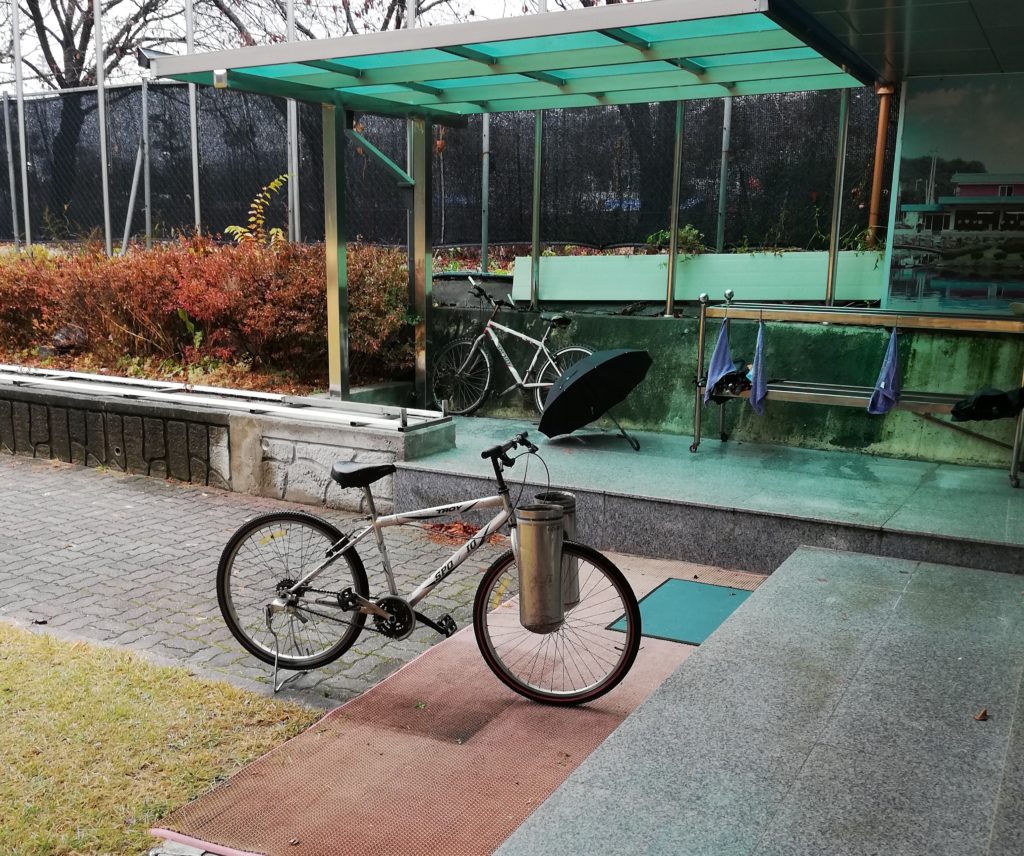
Some more senior members, or those less able to walk 145m and back, can make use of a simple device which allows them to shoot their bows without having to walk: on the side of the shooting line, adjacent to the clubhouse- stands a tall flagpole with the arrow shaft attached to it with a strong thread, so that the archer can still point at the target giving the body the correct gradient.
The arrow, once loosed, will spring back around the flagpole and come back around to its resting position. This device can also be used as an exercise machine by any archer, including complete novices.
A word of advice to those contemplating a trip to experience KTA: work on mastering the thumb draw (preferably with a Turkish style ring otherwise it will not allow for tight gripping and let you use your back properly), and arrange your trip in advance because most Koreans will generally assume you only want to try for an end of two. Stay tuned for more adventures in Korea next month!


How can you arrange a trip to Korea to practise KTA? Is there someone you can contact or something? Any advice on that?